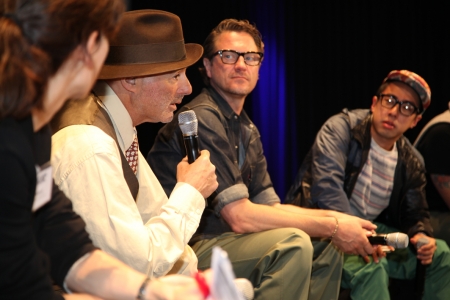
In their first Future of Fashion Summit, Sportswear International provided a unique platform in Berlin, July 3, 2012, the day before Bread & Butter Trade Show for an impressive group of key speakers and topics ranging from changes in fashion and denim retail, to the Digital Lifestyle of today’s consumers (stay tuned for Label Networks’ Summer Youth Culture Study 2012—“The Digital Lifestyle” release July 15), POS emotional impacts, and brand transparency.
Here’s what went down:
The Topics of the Day: Will online shopping be the death of brick-and-mortar establishments or will it revitalize them? What will be the most influential looks, styles, colors and inspirations to hit fashion in the months and years ahead? What is a pair of jeans actually worth and how much of that is understood by the customer? How will retail and industry continue to find synergies and who will be the key players in these deals?
The Experts and Guests
Global experts, including Torsten Widarzik, general manager Levi’s, Xavier Court, co-founder of Vente-Privee, Jason Denham, CEO and founder of Denham the Jeanmaker, Stefan Puriss, CEO Frontline, Scott Morrison, president & designer 3×1, and Michael Paradise, owner of The Stronghold, shared insights with a live audience and participants from different industries such as retailer Andreas Feldenkirchen, CEO Feldenkirchen, Christian Gerhardt, buyer at Breuninger department store, Lori Swale, district manager Urban Outfitters, Dietmar Senft, CEO Crämer & Co., Silvia Urbon, head of marketing Hugo Boss international markets, and Rene Sadina, sales representative Nespresso.
The Results
The congress started with a speech by Trendwatcher Mathias Haas, who shared his expertise and perspective on relevant megatrends and their impact on the consumer’s behavior. One aspect he pointed out was, “The more transparent you as a brand are, the more trust you will earn.” For example, although Patagonia said to not buy their jackets in one of its ads, the company’s results went up by 25% in the past two years. “Reduce information and use large, symbolic images, act based on available data, be analytic, sharpen your digital profile and become a ‘profiler’ for your client. You shouldn’t think in target groups anymore, you should think in target individuals,” he said. Haas’ other tip for the clothing industry: “Create a story!”
For Bert Martin Ohnemüller, CEO of Neuromerchandising group, “Emotions and senses drive all of our decisions and are key of what information we keep in mind. Holistic, multisensory concepts and experiences should be key for a successful retail strategy.”
He talked about how to transform the point of sale into a point of success by revealing appealing opportunities through several aspects of neuromerchandising. “The POS needs more positive emotions,” he said.
On how to create positive emotions, John Ryan showed some examples of the most forward and latest in-store innovations such as Levi’s (London), Ted Baker (Tokyo), and Superdry, Esprit and Acne. The store editor of Retail Week talked about how to be different when everything is the same and how to present entertaining elements, ruling successful retail.
Furthermore, Ryan gave insights on how to strengthen consumers’ experience of the brand and how to delight their shopping experience. “We don’t care about trends,” Thorsten Widarzik, general manager Levi’s Germany, said. “Innovation is our recipe to create a successful business that is longer lasting than the market and that serves the consumer’s needs.” In his speech, he explained how to remain a global market leader and how to stay meaningful to the consumers, exemplified by several projects and platforms including 100 Yards festival, the waterless initiative and other communication and marketing tools. Demonstrating the brand’s strong bond with retail, Levi’s announced the re-opening of its former Buttenheim shop next week, located at Alte Schönhauser Strasse in Mitte. “Consumers expect to be surprised and excited by the brand, its products and communication. Send a message the customers can engage with and make them feel to purchase a product,” Widarzik suggested.
Other speakers included Ute Stauss, director of fashion & home at Walt Disney Germany, who reported on fashion collabs pushing the business and the future of partnerships and Prof. Marc Drüner who addressed the future of consumer shopping.
In his keynote speech, Drüner, foresaw the end of the decision to purchase at the point of sale as boundaries between offline and online are blurred. “There is no segmentation in offline and online shops as both are the perfect match. Even if people buy offline, they inform themselves online before,” he said. Furthermore, the CEO of Trommsdorff + Drüner reported on how to use several Web analytics and demonstrated how new data can be used for more business growth and to maximize a company’s business, sales and marketing. “Data is the oil of the 21th century,” Drüner said. “There are three big players in the market: social data, behavioral data and search data. Companies having the most data of people will have the best products in the future,” Drüner believes. “From the search, you can see what people might buy.”
French-based shopping club Vente-Privee takes the opposite track: “We don’t believe in Facebook. It is great for media but not for selling. Sure, we know most about our customers but we don’t use it,” co-founder Xavier Court said. “We are totally Google-free and never spent a dollar on it. We have 2.5 million unique visitors a day who don’t know what we have and what they want. People buy not because they need a new pair of jeans but because they like it. We never ask them to come; we simply recruit members over other members.”
In addition to the keynote speeches different panel discussions rocked the day. The “The Future of Fashion” was discussed by store owners Michael Paradise, Sam Ben Avraham of the US boutique Atrium, Native Shoe’s Damian van Zyll de Jong and Levi’s Torsten Widarzik. The essential findings were: Stretch is not dead, women should be allowed to dress as a man, teenagers are a tough target group, Instagram will be the next Facebook and Michael Paradise can dress absolutely everyone who comes into his store.
Jason Denham, Giusi Bettoni, Scott Morrison, Magdalena Schaffrin and Panos Sofianos debated green fashion together. They said it’s difficult to get a complete offer at international fabric fairs and that the consumer is still not educated and motivated. Jason Denham stated, “There are three things about green fashion: 1. Choose a good and responsible partner with the right values for materials and producing, 2. Make a product long lasting and high quality, 3. Keep the product alive with an after-service.
Two things we’d like to point out from a Label Networks’ point of view is that teens are not necessarily a difficult target market, if you know what’s going on with this demographic. Obviously our global youth culture studies address the changes within youth culture, but there are telltale signs of what’s taking shape a why, which then often trickles upwards to what designers in high-end fashion and denim end up doing.
A second point that we’d like to make is that while the group who debated green fashion does not think that the consumer is educated and motivated, we have data and analysis in the opposite direction. As we’ve stated many times in our Youth Culture Studies and ongoing stories, green fashion is essential to capturing future demographics as today’s youth demographic is far more eco-savvy that ever before. Knowing the fabric’s story is becoming increasingly important.


